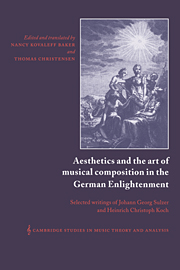 Aesthetics and the Art of Musical Composition in the German Enlightenment
Aesthetics and the Art of Musical Composition in the German Enlightenment Book contents
- Frontmatter
- Contents
- Foreword by Ian Bent
- PART I JOHANN GEORG SULZER GENERAL THEORY OF THE FINE ARTS (1771–74): SELECTED ARTICLES
- PART II HEINRICH CHRISTOPH KOCH INTRODUCTORY ESSAY ON COMPOSITION, VOL. II (1787)
- Introduction by Nancy Kovaleff Baker
- Preface
- Introduction
- I The aim and the inner nature of compositions and, above all, the way in which they arise
- Index
Introduction by Nancy Kovaleff Baker
Published online by Cambridge University Press: 30 September 2009
- Frontmatter
- Contents
- Foreword by Ian Bent
- PART I JOHANN GEORG SULZER GENERAL THEORY OF THE FINE ARTS (1771–74): SELECTED ARTICLES
- PART II HEINRICH CHRISTOPH KOCH INTRODUCTORY ESSAY ON COMPOSITION, VOL. II (1787)
- Introduction by Nancy Kovaleff Baker
- Preface
- Introduction
- I The aim and the inner nature of compositions and, above all, the way in which they arise
- Index
Summary
Heinrich Christoph Koch's central aim in writing his Versuch einer Anleitung zur Composition was to provide comprehensive instruction in composition. In this three-volume work, Koch formulates many rules and guidelines based upon his study of the current repertory to aid the beginning composer. He was aware, however, that theory alone could not account for all characteristics of music and therefore could not provide a complete foundation for compositional pedagogy. He thus sought to relate theory to aesthetics in order to explain the more intangible aspects of the art of composition. What in fact is the general purpose of a fine art such as music and how does this purpose help shape a given work? How would such a composition arise in the mind of a composer? Koch's answers to these and other questions in the following translation outline a process of composition which is guided by aesthetic considerations. His primary source was the extensive writings of Johann Sulzer, discussed and translated in this volume. Sulzer's theory of the fine arts was elaborate, but abstract with regard to particular arts, especially music. Koch, however, applied Sulzer's aesthetic ideas specifically to music and provided concrete illustrations. Irrespective of the question whether these ideas offer a practicable approach to learning composition, this portion of Koch's treatise is unique in the field of music theory and a significant contribution to the growing body of works concerning the process of composition in the latter part of the eighteenth century.
- Type
- Chapter
- Information
- Aesthetics and the Art of Musical Composition in the German EnlightenmentSelected Writings of Johann Georg Sulzer and Heinrich Christoph Koch, pp. 111 - 136Publisher: Cambridge University PressPrint publication year: 1996


